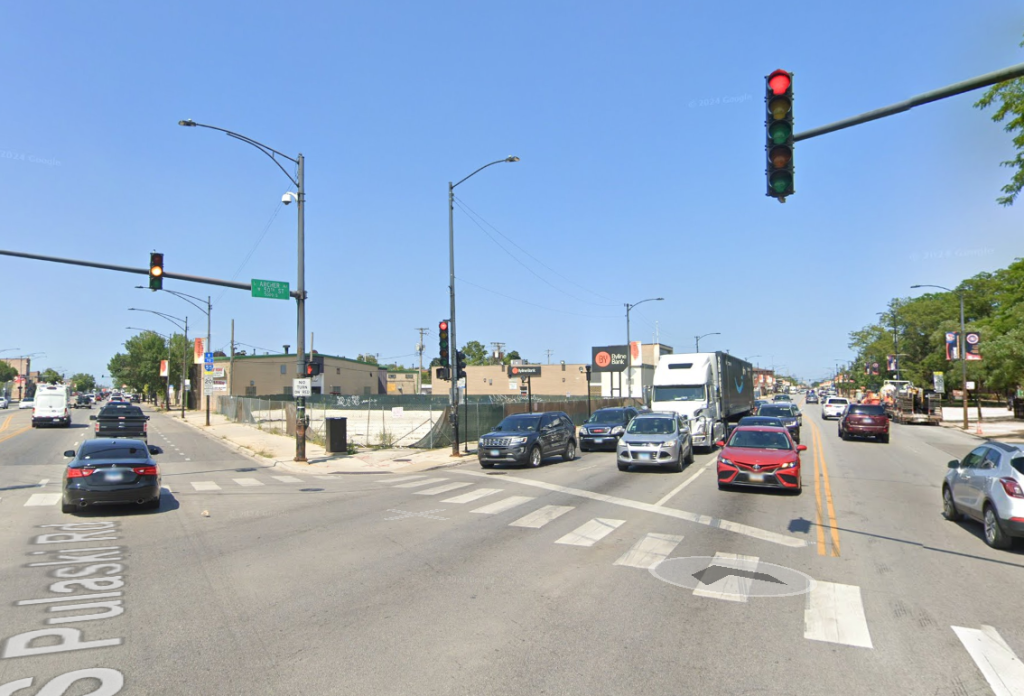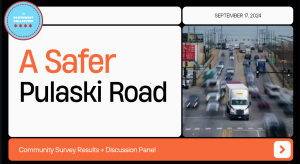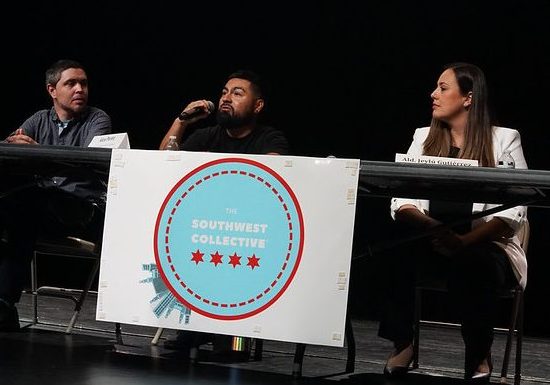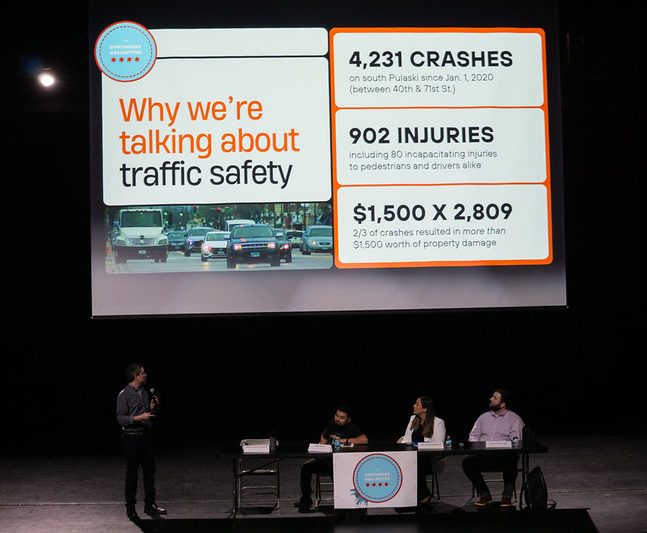When was the last time you attempted to cross a busy road on foot? Picture heavy trucks rushing by, cars running red lights, and numerous vehicles speeding. Imagine trying to gauge how quickly you can run from one side to the other, crossing not just two or three, but perhaps four or even eight lanes.
Crossing a busy road in the Chicago region is a dangerous experience that too many people must contend with. Often, it’s life-threatening. Sometimes, it’s deadly.
A stretch of Pulaski Road on Chicago’s Southwest Side has become particularly infamous for speeding drivers and dangerous crashes. The wide and busy road, with three to four lanes, cuts directly through the neighborhoods. Safety concerns span the entire corridor on the Southwest Side, stretching from 40th Street to 71st street.
So far this year, over 665 crashes, 136 injuries and three fatalities have been reported.
For months, the community has been rallying around possible solutions, demanding change for local residents.
RESIDENTS ARE FED UP
Earlier this summer, Active Transportation Alliance partnered with the neighborhood group The Southwest Collective to take a closer look at the safety issues on Pulaski Road.
An online safety survey gathered nearly 500 responses from residents about the changes they want to see on Pulaski. About 50 residents, Chicago Department of Transportation (CDOT) personnel, and elected officials participated in a series of eight in-person walks highlighting stretches where people feel particularly unsafe.
At a recent community meeting at Curie High School in Archer Heights, more than 60 neighbors gathered to hear the results of these efforts compiled by the group.
THE LARGER PROBLEM
“Too many neighbors have been killed crossing the street on foot — something we should all be able to do [safely],” said Dixon Galvez-Saerle, founding member of the Southwest Collective.
“A lot of people in the community were outraged, saddened and furious about this, and rightfully so. Not just because these are tragic incidents in themselves, but because we know they’re indicative of a larger problem.”
City data from 2020 to 2024 reveals:
- Over 4,200 crashes, on a 30 plus block stretch on South Pulaski
- More than 900 injuries, 80 of them incapacitating
- Property damage exceeding $ 1,500 for two-thirds of the accidents,
excluding medical bills
As Galvez-Saerle explains, the problem is that Pulaski is built for cars to go fast and is lacking infrastructure to keep people safe while they are walking. It’s a very wide street that makes local residents hesitant to walk alongside it and cross it on foot.
Even though Southwest Siders don’t want to use their car for every single trip, safety issues force them “to drive everywhere, from the grocery store to [their] kid’s schools and even to the Pulaski Orange Line.”
Community feedback shows that speeding is by far the largest safety concern, followed by the prevalence of heavy truck traffic and limited time to walk across Pulaski Road.
The in-person walks highlighted another core issue: Cars and trucks frequently drive in the median and in the parking lane, at a high speed to cut in front of other vehicles, endangering pedestrians and themselves.

The intersection of Archer Avenue (right) and Pulaski (left) is one of the areas of concern, being so close to Curie High School and the Orange Line. Source: Google Maps
SHORT AND LONG-TERM SOLUTIONS
Together with Southwest Collective, we identified a set of short and long-term solutions to address the issues on South Pulaski.
Short-term solutions:
- Refuge islands and bump-outs make it impossible for cars and trucks to drive through the median or parking lane
- Bus-bulbs mean buses don’t have to merge back into traffic at bus stops
- Investment in frequent and reliable public transportation (especially bus service) connects neighborhoods to each other and to the rest of the city
- Monitoring any new red light or speed cameras helps identifying issues early on
Long-term solutions:
- Tree planters help prevent people from driving in the median, cool Pulaski, and increase the tree canopy in the industrial neighborhoods
- Bus-rapid transit allows buses to function as quickly as the Orange Line, and offers a convenient alternative to car-travel
“SOMETHING GOOD IS HAPPENING HERE”
At the community meeting, CDOT representative Jakob Boxberger shared encouraging news. CDOT has begun addressing safety concerns on Pulaski Road, starting with quick measures that don’t require approval from IDOT, such as improving crosswalk visibility and installing bollards and flexible delineators.
In 2025, the city hopes to implement raised curb improvements and bus bulbs.
“Something good is happening here,” said Alderwoman Jeylu Gutierrez. “For the first time, all the levels of government are working together on this issue. We are committed to bringing change to the community.”
Gutierrez also highlighted a citywide initiative that will further enhance safety: Alderman Daniel La Spata’s July 2024 ordinance proposing lower speed limits across Chicago.
A PULASKI ROAD THAT SERVES THE COMMUNITY
As plans for short-time measures start to take shape, together with a city-wide push for lower speed limits, and a strengthened commitment of all levels of government to take the voices of community members seriously, there is hope that South Pulaski will eventually be transformed into a safer road for pedestrians and drivers alike.
“My ten-year vision for Pulaski is a street that is responsive to what the community wants, […] so that we can make sure that the street really serves people that live closest by,” concludes Galvez-Saerle.

Click here to view the survey results presented at the community meeting at Curie High School.
You care about road safety and want to help build communities where everyone feels secure while walking, biking, or driving?
Tell your alderperson that you support lowering the citywide speed limit from 30 mph to 25 mph today, and follow Southwest Collective’s work to stay informed about changes on Pulaski Road.



